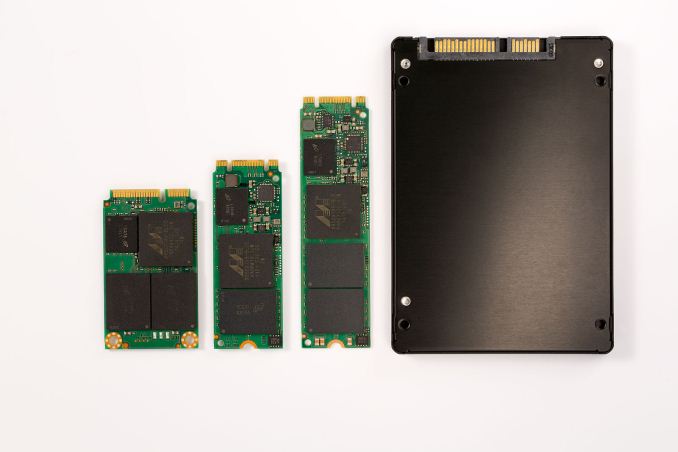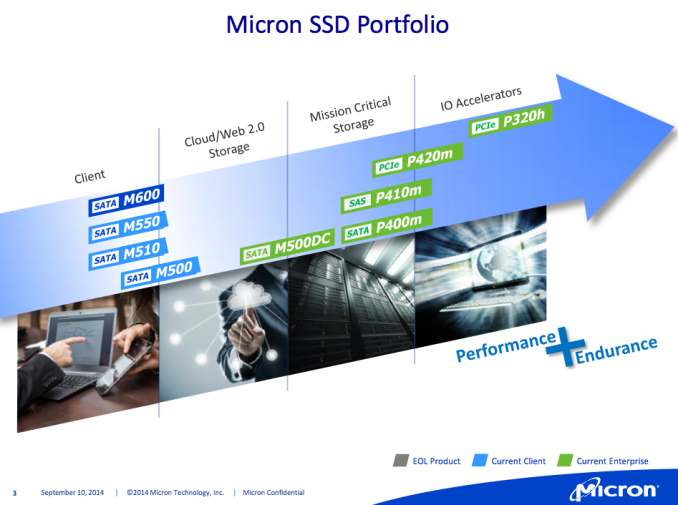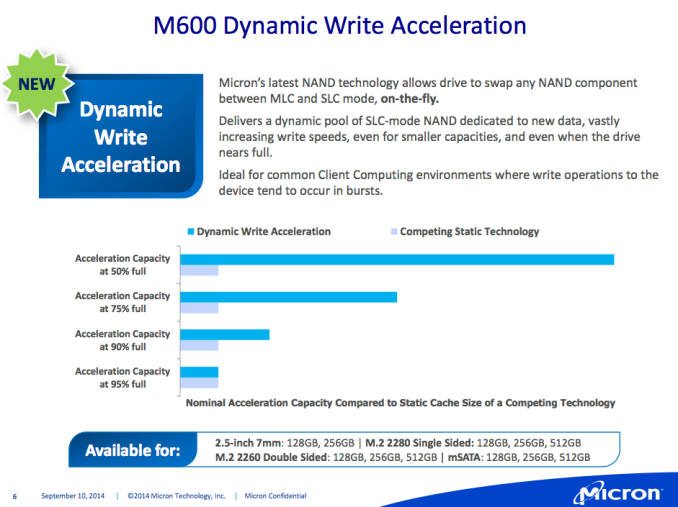Micron Launches M600 Client SSD for OEMs/SIs
by Kristian Vättö on September 16, 2014 10:00 AM EST
Micron/Crucial has been one of the go-to manufacturers for value client SSDs during the past couple of years, but the one thing that the company has lacked is a higher performing solution. The M600 that is being released today is Micron's answer to the demand for a more high-end SSD with better performance.
The M600 is positioned in the client segment above the M550, making it the highest-end drive that Micron offers for client workloads. Note that the M600 is a Micron-only product and is only available for OEMs and SIs, meaning there is not going to be a Crucial branded retail counterpart and you will not be seeing the M600 on the store shelves. Micron and Crucial have separated some parts of their product development because the needs of the OEM and retail markets are a bit different, so from now on the difference between Micron and Crucial SSDs will more than just the label. The engineering core should still be the same, though, and some of the features that are introduced in the M600 will find their way to Crucial branded SSDs too.
| Micron M600 Specifications | |||||
| Capacity | 128GB | 256GB | 512GB | 1TB | |
| Controller | Marvell 88SS9189 | ||||
| NAND | Micron 128Gbit 16nm MLC | ||||
| Form Factors | 2.5" 7mm, mSATA & M.2 2260/2280 | 2.5" 7mm | |||
| Sequential Read | 560MB/s | 560MB/s | 560MB/s | 560MB/s | |
| Sequential Write | 400MB/s | 510MB/s | 510MB/s | 510MB/s | |
| 4KB Random Read | 90K IOPS | 100K IOPS | 100K IOPS | 100K IOPS | |
| 4KB Random Write | 88K IOPS | 88K IOPS | 88K IOPS | 88K IOPS | |
| Idle Power (DevSleep/Slumber) | 2mW / 95mW | 2mW / 100mW | 2mW / 100mW | 3mW / 100mW | |
| Max Power | 3.6W | 4.4W | 4.7W | 5.2W | |
| Encryption | TCG Opal 2.0 & eDrive | ||||
| Endurance | 100TB | 200TB | 300TB | 400TB | |
| Warranty | Three years | ||||
The M600 is available in four form factors: 2.5" 7mm, mSATA and both 2260 and 2280 flavors of M.2. The 2260 is double-sided, whereas the 2280 is single-sided, which explains why both max out at 512GB and the 1TB model is only available as a 2.5" 7mm drive.
The controller remains unchanged from the M550, but the M600 switches to Micron's latest 128Gbit 16nm NAND like the MX100 did a few months ago. Despite the same hardware as the MX100 has, the M600 is a different product. The most important new feature in the M600 is what Micron calls Dynamic Write Acceleration.
Dynamic Write Acceleration (DWA) is Micron's implementation of a pseudo-SLC cache. Instead of being static with a predetermined amount of NAND set in SLC mode, DWA is dynamic and can switch between SLC and MLC on the fly. In other words, an empty SSD will run nearly all of its NAND in SLC mode to increase performance and the size of the SLC cache decreases as the drive is filled. At 95% full, most of the NAND will now be running in MLC to meet the advertised user capacity, but the size of the SLC cache is still comparable to competitors' static SLC caches. DWA is transparent to the user so the shown capacity of the drive will not change -- the drive itself manages the change between SLC and MLC in the background.
For small drives the increased capacity and dynamic nature of the SLC cache can be beneficial. With only 128GB or 256GB of NAND and with each die being 16GB, the lower program and read latencies of pseudo-SLC will make a big difference to especially write performance. As a result even the 128GB model achieves peak speeds of 410MB/s sequential write and 88K random write IOPS. The 512GB and 1TB 2.5" models do not use DWA at all because they have enough NAND to provide the same performance without the need for an SLC cache, but all mSATA and M.2 models utilize DWA (including the 512GB ones).
Aside from the increased performance, the benefit of the pseudo-SLC cache is increased endurance. The 128GB model is rated at 100TB, which is a fair increase over the 72TB rating that Micron's previous drives have had. The rating also scales linearly with capacity now, so the 1TB is good for up to 400TB. Keep in mind that the M600 is only validated for typical client usage, which allows for higher ratings because the write amplification will be lower due to a lighter workload.
In addition the M600 features the usual Micron/Crucial feature set. There is DevSleep, TCG Opal and eDrive support as well as power loss protection. The warranty is three years similar to Micron's other client SSDs.
The M600 is available now (though only for OEMs/SIs) and we already have samples, but there is a separate embargo for the reviews, so look out for the review in the next couple of weeks.












15 Comments
View All Comments
hojnikb - Tuesday, September 16, 2014 - link
Hmm, that DWA looks very similar to OCZs performance mode, introduced back with vertex4...Hopefully, this will carry to their budget line aswell.
Kristian Vättö - Tuesday, September 16, 2014 - link
It's not similar at all. OCZ's performance mode had a strict 50% threshold -- either everything was SLC or MLC. In other words, once you filled over 50%, everything went MLC and any future writes would not get any performance increase. DWA still works after the 50% mark because it will move data to the MLC portion in the background before the SLC cache gets full, whereas OCZ's implementation kept everything as SLC until it become full.hojnikb - Tuesday, September 16, 2014 - link
Well, i've seen lots of reports of performance mode working just fine after 50% mark. It just needs some time to move data around and then it gets its performance back.Could be wrong tho.
hojnikb - Tuesday, September 16, 2014 - link
Obviously, if you trash it with constant writes, it will drop performance after 50% mark. But it will regain performance back after some time. Unless those bechmarks lie somehow :)Kristian Vättö - Tuesday, September 16, 2014 - link
If hammered with constant writes, the drop in write performance is bigger with OCZ's performance mode because the drive is still migrating data from SLC to MLC while processing the host writes. Once the migration has been completed, performance will recover, but not to the original clean state because the whole drive is now operating in MLC mode.DWA will show similar behavior with constant writes, but with the difference that the SLC cache is still functional after the 50% mark (but just smaller).
hojnikb - Tuesday, September 16, 2014 - link
>. Once the migration has been completed, performance will recover, but not to the original clean state because the whole drive is now operating in MLC mode.Yeah, but i've seen numerous reports of Vertex4 back in the day, that had write speeds near its maximum even after 50% full. So it was either an error in benchmarking or OCZs performance mode actually treats remainder of free flash still as pSLC. It just waits till 50% before it starts doing anything at all to normal MLC. Atleast thats how i see. Either way, it would be interesting to see this benchmarked again in newer drive. As i understand they still use this.
So fill the drive to 75%, wait some time (30m-1h) and benchmark again. If performance mode isn't functional beyond 50%, write speeds should stay at MLC levels.
MrSpadge - Tuesday, September 16, 2014 - link
"If performance mode isn't functional beyond 50%, write speeds should stay at MLC levels."That could be the problem of those investigations. Do we know just how fast or slow the pure MLC write speeds are on those drives? Maybe they're not as slow as people think (pretty much everyone else is using pure MLC for a reason) tey should be, and hence performance mode may be off but since the performance measured is still pretty good people may think the drive is still performance mode. The effect of performance mode should also depend on the workload / benchmark.
hojnikb - Tuesday, September 16, 2014 - link
Yeah, MLC gets pretty fast beyond 128GB (or 256GB in case of 128Gbit dies). Still, this whole 50% theory could be easily tested on 128GB drives. Afterall, they benefit the most. So if pSLC is still somewhat functional after 50%, this should be easily seen in benchmarks. If not, such ssd would have noticebly lower write speeds at stay 75% full, regardless of idle time.hojnikb - Tuesday, September 16, 2014 - link
say*really, still no edit ?
hojnikb - Tuesday, September 16, 2014 - link
... if the drive is indeed stuck in normal mode, until you make more than 50% free space.